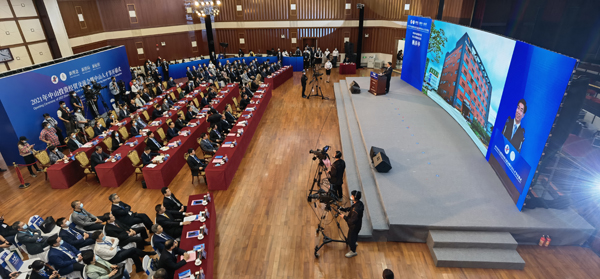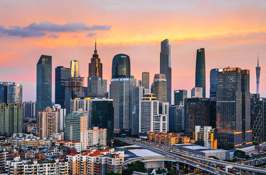Zhongshan sets to upgrade industries for growth

Zhongshan in Guangdong province holds the Trade and Investment Fair and Top Talent Networking event on Sunday, with a group of selected investment projects signed. XIA SHENGQUAN/FOR CHINA DAILY
A group of selected investment projects were signed on Sunday in Zhongshan, a burgeoning city in South China's Guangdong province, to upgrade its industrial chains for faster growth.
The Pearl River Delta city recorded strong year-on-year rises in investments last year. Industry, industrial technological innovation and high-tech manufacturing recorded 49.8 percent, 39.2 percent and 83.4 percent increases in investment respectively. The indexes were widely seen to provide a strong foundation for the city's high-quality development.
The city government continues to attract external investment and talent to boost its industrial strength. Two high-profile efforts are the Zhongshan Trade and Investment Fair and Top Talent Networking Zhongshan event, which are held every spring.
According to the organizer, the fair this year focused on 72 major projects valued at nearly 45 billion yuan ($6.88 billion) in total, of which investment could surpass 1 billion yuan across 16 projects.
Due to the COVID-19 pandemic, 43 projects were signed via electronic agreement. Results were projected on the screen at the opening ceremony on Sunday.
They fall into six major categories: scientific and innovative platforms; healthcare and medicine; new-generation information technology; modern services; high-end equipment manufacturing; and the transformation and upgrade of local key enterprises.
Some of the projects are clearly promising and could have a positive influence not only on Zhongshan but the whole province or even the country, senior officials said. The projects include an industrialization platform for helium technology, research on the world's first new drug for osteonecrosis and a new drug research for diabetes.
Lai Zehua, Party secretary of Zhongshan, said the city will provide VIP service to the investors to make sure that every preferential policy for companies is fully implemented.
"We will give more powerful solutions to solve the difficulties of companies this year," said Lai. "No matter how difficult it is and how big the input will be, as long as it's worth it, we will make it."
Lai said at the opening ceremony that the door of Zhongshan is always open to innovative companies, projects and talent. "You can trust your dreams to Zhongshan," he said.
As Zhongshan is located in a central site of the Guangdong-Hong Kong-Macao Greater Bay Area, the local government announced a plan in 2019 to invest about 150 billion yuan over the next five years to improve the transport network. The goal was to link Zhongshan and other cities in the Bay Area to within half-an-hour's journey of each other.
Lai also pointed out that Zhongshan has a complete industrial chain that can turn the world's newest innovative ideas or products into reality. Moreover, it has integrated with leading cities in the Bay Area to participate in the construction of their scientific and innovative platforms, he noted.
Wei Weihan, mayor of Zhongshan, said the city government has improved the land resources management system over the past few years.
The city has sorted out more than 3,333 hectares of land over the past three years, he said. This year, no less than 2,000 hectares of industrial land will be sorted out and made available to companies, he added.
The project of confocal microscopy apparatus with ultrahigh resolution, an optical imaging technique, was developed by Harbin Institute of Technology. It will settle in the Cuiheng New Area of Zhongshan to build a research and manufacturing base.
Wang Hongbo, a senior official of the HIT research institute in Zhongshan, said the city has advantages in funds, talent and industrial infrastructure. The construction of the national scientific park for important apparatuses in Cuiheng also provides sound infrastructure and preferential policies to the project.
The project is expected to begin mass production by the end of this year and sell to the domestic market in 2022. It will be significant to some sectors-like major photoelectric equipment, space cameras and semiconductor detectors-that heavily depend on imports, Wang said.



 Print
Print Mail
Mail

